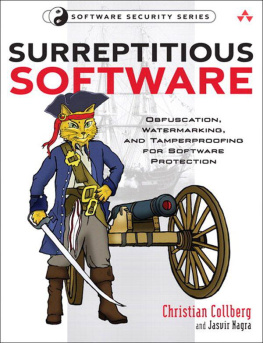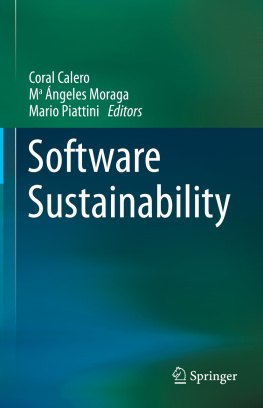Christian Collberg - Surreptitious Software: Obfuscation, Watermarking, and Tamperproofing for Software Protection
Here you can read online Christian Collberg - Surreptitious Software: Obfuscation, Watermarking, and Tamperproofing for Software Protection full text of the book (entire story) in english for free. Download pdf and epub, get meaning, cover and reviews about this ebook. year: 2009, publisher: Addison-Wesley Professional, genre: Computer. Description of the work, (preface) as well as reviews are available. Best literature library LitArk.com created for fans of good reading and offers a wide selection of genres:
Romance novel
Science fiction
Adventure
Detective
Science
History
Home and family
Prose
Art
Politics
Computer
Non-fiction
Religion
Business
Children
Humor
Choose a favorite category and find really read worthwhile books. Enjoy immersion in the world of imagination, feel the emotions of the characters or learn something new for yourself, make an fascinating discovery.
- Book:Surreptitious Software: Obfuscation, Watermarking, and Tamperproofing for Software Protection
- Author:
- Publisher:Addison-Wesley Professional
- Genre:
- Year:2009
- Rating:5 / 5
- Favourites:Add to favourites
- Your mark:
Surreptitious Software: Obfuscation, Watermarking, and Tamperproofing for Software Protection: summary, description and annotation
We offer to read an annotation, description, summary or preface (depends on what the author of the book "Surreptitious Software: Obfuscation, Watermarking, and Tamperproofing for Software Protection" wrote himself). If you haven't found the necessary information about the book — write in the comments, we will try to find it.
Mikhail Atallah, Distinguished Professor of Computer Science at Purdue University
Theory, Techniques, and Tools for Fighting Software Piracy, Tampering, and Malicious Reverse Engineering
The last decade has seen significant progress in the development of techniques for resisting software piracy and tampering. These techniques are indispensable for software developers seeking to protect vital intellectual property. Surreptitious Software is the first authoritative, comprehensive resource for researchers, developers, and students who want to understand these approaches, the level of security they afford, and the performance penalty they incur.
Christian Collberg and Jasvir Nagra bring together techniques drawn from related areas of computer science, including cryptography, steganography, watermarking, software metrics, reverse engineering, and compiler optimization. Using extensive sample code, they show readers how to implement protection schemes ranging from code obfuscation and software fingerprinting to tamperproofing and birthmarking, and discuss the theoretical and practical limitations of these techniques.
Coverage includes
- Mastering techniques that both attackers and defenders use to analyze programs
- Using code obfuscation to make software harder to analyze and understand
- Fingerprinting software to identify its author and to trace software pirates
- Tamperproofing software using guards that detect and respond to illegal modifications of code and data
- Strengthening content protection through dynamic watermarking and dynamic obfuscation
- Detecting code theft via software similarity analysis and birthmarking algorithms
- Using hardware techniques to defend software and media against piracy and tampering
- Detecting software tampering in distributed system
- Understanding the theoretical limits of code obfuscation
Christian Collberg: author's other books
Who wrote Surreptitious Software: Obfuscation, Watermarking, and Tamperproofing for Software Protection? Find out the surname, the name of the author of the book and a list of all author's works by series.
















 For more information about these titles, and to read sample chapters, please visit informit.com/softwaresecurityseries
For more information about these titles, and to read sample chapters, please visit informit.com/softwaresecurityseries